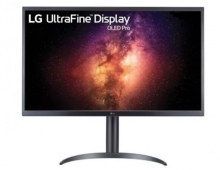
LG.Philips LCD's 15-Inch Notebook PC Panel World's Lowest Power and Brightest Single Lamp 15-Inch Display
LG.Philips announced that its LP150X10-A3 panel was measured to be the world's lowest power(1), amorphous silicon, 15.0-inch XGA (1024 x 768 resolution format) TFT-LCD for notebook PCs.
The LP150X10-A3 was also found to be the brightest single lamp panel available on the market(1). These two distinctions position the LP150X10-A3 as an optimal display for consumer and enterprise notebook PCs, as it supports longer battery life and higher quality visual performance.
"Today's wireless world requires large and wide displays of all types," said Bruce Berkoff, Executive Vice President of Marketing for LG.Philips LCD. "We are happy to see that our progress in developing large and wide, light-weight and lower power notebook PC displays is being noticed by the mobile PC industry. LG.Philips LCD remains committed to producing large and wide, low-power display panels such as the LP150X10-A3 in order to meet the needs of industry-leading mobile PC manufacturers."
The LP150X10-A3 display features XGA resolution (1024 x 768), weighs only 565 grams, helping to lower the overall weight of notebook PCs, and can achieve a brightness of 400nits.
As notebook PCs become ubiquitous for computing, entertainment, and communication, the need for improved visual performance and longer battery life become paramount. The Mobile PC Extended Battery Life Working Group (EBL-WG)(2) a group of companies working together to extend the battery life of mobile PCs, has been focused on display subsystem power reduction since its inception, as this subsystem consumes the most power in the notebook PC(3). "LG.Philips LCD's announcement today clearly demonstrates that improved visual performance and longer battery life can go hand in hand," said Kamal Shah, display strategy and mobility enabling initiative manager, Mobile Platforms Group, Intel, and chairman of the Mobile PC EBL-WG. "LG Philips LCD's innovative display sets a new bar for innovation among display manufacturers, and should help contribute to better awareness and broader availability of low-power and longer-battery-life notebook PCs."
LG.Philips LCD's ongoing leadership in the development of large and wide notebook PC displays with low inherent power consumption is helping to enable the next generation of highly functional and mobile notebook PCs.
"Today's wireless world requires large and wide displays of all types," said Bruce Berkoff, Executive Vice President of Marketing for LG.Philips LCD. "We are happy to see that our progress in developing large and wide, light-weight and lower power notebook PC displays is being noticed by the mobile PC industry. LG.Philips LCD remains committed to producing large and wide, low-power display panels such as the LP150X10-A3 in order to meet the needs of industry-leading mobile PC manufacturers."
The LP150X10-A3 display features XGA resolution (1024 x 768), weighs only 565 grams, helping to lower the overall weight of notebook PCs, and can achieve a brightness of 400nits.
As notebook PCs become ubiquitous for computing, entertainment, and communication, the need for improved visual performance and longer battery life become paramount. The Mobile PC Extended Battery Life Working Group (EBL-WG)(2) a group of companies working together to extend the battery life of mobile PCs, has been focused on display subsystem power reduction since its inception, as this subsystem consumes the most power in the notebook PC(3). "LG.Philips LCD's announcement today clearly demonstrates that improved visual performance and longer battery life can go hand in hand," said Kamal Shah, display strategy and mobility enabling initiative manager, Mobile Platforms Group, Intel, and chairman of the Mobile PC EBL-WG. "LG Philips LCD's innovative display sets a new bar for innovation among display manufacturers, and should help contribute to better awareness and broader availability of low-power and longer-battery-life notebook PCs."
LG.Philips LCD's ongoing leadership in the development of large and wide notebook PC displays with low inherent power consumption is helping to enable the next generation of highly functional and mobile notebook PCs.





















